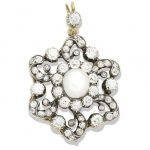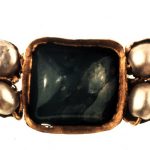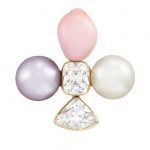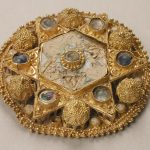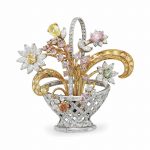Information and history of pearls plus a gallery of pearls used in antique and vintage brooches. Natural pearls have been used for centuries both in brooches and other jewellery as well as for buttons and other dress ornaments. Natural pearls are found in the wild and very valuable due to their rarity.
Cultured pearls have been farmed and foreign material introduced to form the pearl. Cultured pearls can be distinguished from natural pearls by X-ray examination. Nucleated cultured pearls are often ‘preformed’ as they tend to follow the shape of the implanted shell bead nucleus. After a bead is inserted into the oyster, it secretes a few layers of nacre around the bead; the resulting cultured pearl can then be harvested in as few as six months.
When a cultured pearl with a bead nucleus is X-rayed, it reveals a different structure to that of a natural pearl. A beaded cultured pearl shows a solid center with no concentric growth rings, whereas a natural pearl shows a series of concentric growth rings. A beadless cultured pearl (whether of freshwater or saltwater origin) may show growth rings, but also a complex central cavity, witness of the first precipitation of the young pearl sac. Reference: Wikipedia
Roman gold brooch with an emerald flanked by pearls. 2ndC-3rdC
Sold for CHF 68,750 at Christies in 2018
THE WHITE BUTTON PEARL AND QUEEN CONCH PEARL ARE SALTWATER. Cushion-shaped diamond: J-K-VS. Triangular-shaped diamond: G-H-I-VS2, gold bezel uneven on two sides. Gray pearl: light gray with faint rose and green hues, minor bubbles, dimple and minor pitting near edge, dome-shaped, very good luster. White pearl: creamy with greenish hue, minor bubbles and scratches, rounded dome-shaped, medium luster. Conch pearl: pale pink with medium light pink around tip portion, lighter pink overall than catalogue and online photos, abrasion patch upper center, slightly visible to eye, flame pattern on sides, flames on left side slightly visible, very good luster. Good condition. Normal wear. Well-made. 1 5/16 x 1 1/4 inches.
Sold for $87,500 (includes buyer’s premium) at Doyle New York in 2018
CARVED CITRINE SURROUNDED BY PEARLS & DIAMONDS, 13 TOTAL G. 1 1/8″DIA
Sold for $475 at Turkey Creek Auctions in 2018
This brooch in the shape of a star is decorated with miniature architectural forms constructed of fine gold filigree and granulation. It is the kind of adornment worn by high-ranking members of the court of the Ottonian emperors. Circa 970–1030 and probably made in Italy
Reference: The Metropolitan Museum of Art
Cultured pearl and diamond brooch, Van Cleef & Arpels Of floral design, the center set with a cultured pearl measuring approximately 14.80 x 15.35 x 17.90mm, highlighted with single-, circular-cut and cushion-shaped diamonds, suspending a detachable pendant set with a drop shaped cultured pearl measuring approximately 15.65 x 16.22 x 19.47mm, capped with brilliant-cut diamonds, signed Van Cleef & Arpels, numbered, French assay marks for gold and maker’s marks.
Sold for 47,500 CHF at Sothebys in 2018
Enamelled gold dress ornament with a central openwork heart with a skull and cross-bones, two arrows and other devices, with rubies, emeralds, a table-cut diamond and hung with pearls, probably Germany, about 1575-1600.
Reference: © Victoria and Albert Museum
